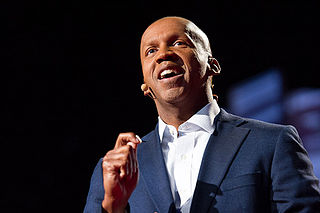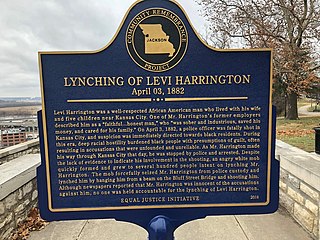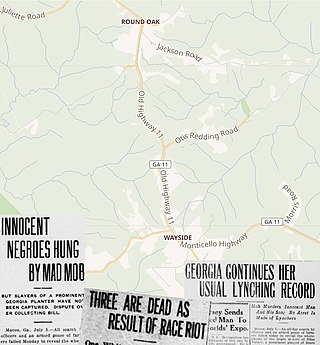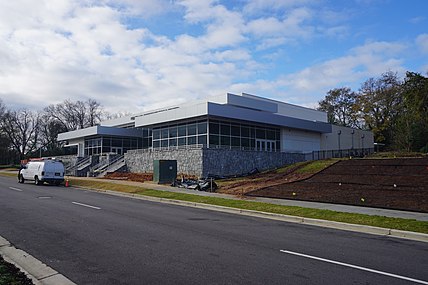
Dallas County is a county located in the central part of the U.S. state of Alabama. As of the 2020 census, its population was 38,462. The county seat is Selma. Its name is in honor of United States Secretary of the Treasury Alexander J. Dallas, who served from 1814 to 1816.
A torture murder is a murder where death was preceded by the torture of the victim. In many legal jurisdictions a murder involving "exceptional brutality or cruelty" will attract a harsher sentence if the killing is not sanctioned by authorities or carried out by state security forces themselves.

The Montgomery Advertiser is a daily newspaper and news website located in Montgomery, Alabama. It was founded in 1829.

Letohatchee is an unincorporated community in Lowndes County, Alabama, United States. It has a very small population and four businesses. The community is part of the Montgomery Metropolitan Statistical Area.

Bryan Stevenson is an American lawyer, social justice activist, law professor at New York University School of Law, and the founder and executive director of the Equal Justice Initiative. Based in Montgomery, Alabama, he has challenged bias against the poor and minorities in the criminal justice system, especially children. He has helped achieve United States Supreme Court decisions that prohibit sentencing children under 18 to death or to life imprisonment without parole. He has assisted in cases that have saved dozens of prisoners from the death penalty, advocated for the poor, and developed community-based reform litigation aimed at improving the administration of criminal justice.
The Equal Justice Initiative (EJI) is a non-profit organization, based in Montgomery, Alabama, that provides legal representation to prisoners who may have been wrongly convicted of crimes, poor prisoners without effective representation, and others who may have been denied a fair trial. It guarantees the defense of anyone in Alabama in a death penalty case.
Austin Callaway, also known as Austin Brown, was a young African-American man who was taken from jail by a group of six white men and lynched on September 8, 1940, in LaGrange, Georgia. The day before, Callaway had been arrested as a suspect in an assault of a white woman. The gang carried out extrajudicial punishment and prevented the youth from ever receiving a trial. They shot him numerous times, fatally wounding him and leaving him for dead. Found by a motorist, Callaway was taken to a hospital, where he died of his wounds.

The Legacy Museum: From Enslavement to Mass Incarceration is a museum in Montgomery, Alabama, that displays the history of slavery and racism in America. This includes the enslavement of African-Americans, racial lynchings, segregation, and racial bias.

Kwame Akoto-Bamfo is a multi-disciplinary artist, educator and activist, known for his sculptures and massive body of works dedicated to the memory, healing and Restorative Justice for people of African descent. His outdoor sculptures are dedicated to the memory of the victims of the Transatlantic slave trade, notably the installation Nkyinkim, on display at the National Memorial for Peace and Justice that opened in 2018 in Montgomery, Alabama. His other sculptures include an installation of 1,200 concrete heads representing Ghana's enslaved ancestors in Accra, the capital of Ghana. Called Faux-Reedom, it was unveiled in 2017.

Levi Harrington was a young African-American who, on April 3, 1882, was abducted from police custody by a large white mob of several hundred participants and lynched in Kansas City, Missouri, hanged from a beam on the Bluff Street Bridge and shot. This followed the fatal shooting of a police officer, Patrick Jones, earlier that day. The next day another man, George Grant, was accused of the crime, and Harrington was declared innocent. However, the evidence against Grant was so weak that he was reportedly tried and acquitted three times and accepted a 2-year prison sentence in a plea bargain on the fourth trial.
John Henry James was an African-American man who was lynched near Charlottesville, Virginia on July 12, 1898, for having allegedly raped a white woman. James had no known family in the area, and had lived in Charlottesville for only five or six years. He was an ice cream seller; "nothing else is known of him."
Elmore County is a county located in the east-central portion of the U.S. state of Alabama. Throughout its history, there have been many lynchings in the county including on July 2, 1901, when a local mob lynched Robert White. In a strange turn of events, a local farmer, George White confessed in court to the killing and named five other local men as killers. Three men were convicted in the killing and sentenced to ten years in prison. On 9 June 1902, they were pardoned by Governor Jelks.

Father and son Alonzo and James D. Green were innocent African-Americans lynched near Round Oak and Wayside, Jones County, Georgia in retaliation for the murder of popular white farmer Silas Hardin Turner on July 4, 1915. A third man, William Bostick was also lynched on this day. None of those killed received a trial.

On September 18, 1921, 16-year-old Eugene Daniel was lynched for walking into a white girl's bedroom.

An 18-year-old African American named William Turner was lynched on November 18, 1921, in Helena, Arkansas, for an alleged assault on a 15-year-old white girl. Two years earlier hundreds of African-Americans were killed during the Elaine Race Riot in Hoop Spur, a nearby community also in Phillips County, Arkansas.

A mob of white Vigo County, Indiana residents lynched George Ward, a black man, on February 26, 1901 in Terre Haute, Indiana, for the suspected murder of a white woman. An example of a spectacle lynching, the event was public in nature and drew a crowd of over 1,000 white participants. Ward was dragged from a jail cell in broad daylight, struck in the back of the head with a sledgehammer, hanged from a bridge, and burned. His toes and the hobnails from his boots were collected as souvenirs. A grand jury was convened but no one was ever charged with the murder of Ward. It is the only known lynching in Vigo County. The lynching was memorialized 120 years later with a historical marker and ceremony.

On October 11, 1878, Jim Good, Jeff Hopkins, Ed Warner, William Chambers, and Dan Harris, Sr. were lynched in Posey County, Indiana, near the town of Mount Vernon. These men, who were allegedly connected to the robbery of a brothel, were killed by a white mob who broke into the jail where they were being held. Two other men, Dan Harris, Jr. and John Harris, were also lynched in the days leading up to October 11, in connection with the same alleged offense. This racial terror lynching is the largest reported lynching in Indiana's history.
Bud Rowland and Jim Henderson, two Black men, were lynched in Rockport, Indiana on December 16, 1900. The following day, Joe Holly was lynched in Boonville, Indiana for the same alleged crime.
The Wicomico Truth and Reconciliation Initiative (WTRI) is a movement in Wicomico County, Maryland, United States, to address the community's history of white supremacy through education and advocacy. The organization was formed in 2018 by James Yamakawa and Amber Green.





















